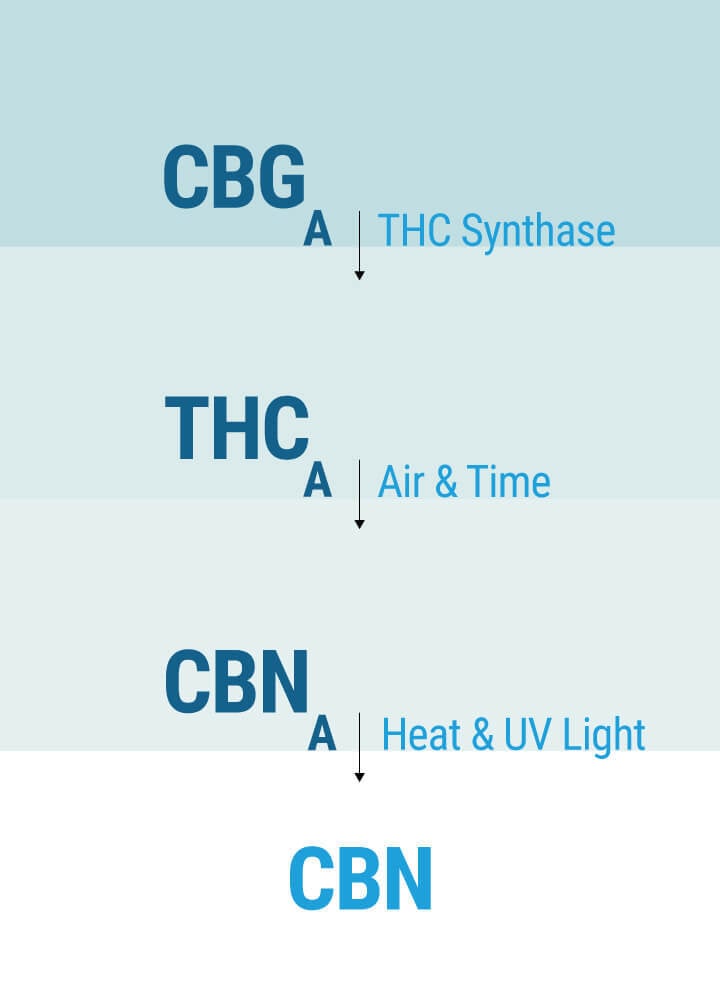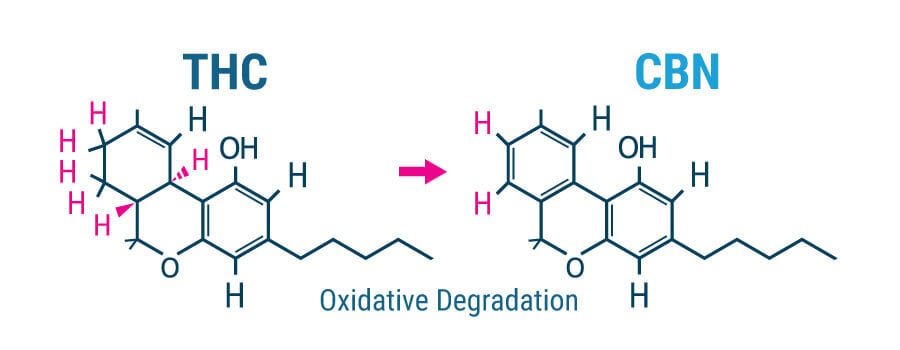.

Cannabinol (CBN): What Is It And What Are Its Effects?
While it receives less of the limelight than THC and CBD, CBN appears in weed as a cannabinoid with its own unique effects. Research on this compound remains early and hypothetical, but initial findings offer an indication of its potential utility in the future. So, what do we know to date about the so-called “sleepy” cannabinoid?
Contents:
CBN, or cannabinol, is far less popular than THC or CBD, and it’s not even so easy to extract from the cannabis plant. However, its potential beneficial effects on human body are beginning to be explored by science. What do we know to date about the “sleepy” cannabinoid?
How Is CBN Formed Within The Cannabis Plant, And Where Is It Found?
Unlike many other cannabinoids, cannabinol (CBN) does not develop from cannabigerolic acid (CBGA). In fact, CBN is a metabolite of tetrahydrocannabinol, which means it develops when THC is heated or exposed to oxygen. For that reason, you’ll find that aged or oxidised cannabis flowers are high in CBN. However, the CBN content within the plant is usually less than 1%, even in cured or aged cannabis flowers.
How Does CBN Exerts Its Effects?
Most cannabinoids exert their effects on our body and mind by chemically “binding” with the cannabinoid receptors that constitute our endocannabinoid system (ECS). In case you're unfamiliar, the ECS is a neuronal messenger network that exists in all of our bodies. It contributes to the regulation of many physiological functions while also influencing mood, immune response, sleep, appetite, pain perception, and much more.
The cannabinoid receptors are named CB1 and CB2, yet we know that several cannabinoids can also influence other receptors. The wide range of different cannabinoids found in cannabis bind to these receptors in different ways, some of them as “agonists” and some as “antagonists,” thus exerting a variety of potential effects.
Much like its parent molecule THC, cannabinol has a greater binding affinity for the CB2 receptor than the CB1 receptor, although CBN’s affinity for CB2 is lower than THC’s. Lab tests show that CBN acts as an agonist at CB1 receptors, albeit with much less strength than THC. CBN is also an agonist at the TRPV2 receptor, potentially contributing to pain-relieving responses. Preliminary studies indicate that cannabinol may also influence enzymes involved in the synthesis and degradation of neurotransmitters.
How Does CBN Affect Our Bodies?
Before we proceed with this section, we should clarify that all studies available today on CBN are early-stage experiments. Not even small-scale clinical data sets have been produced, and people’s anecdotal reports on CBN use are also extremely limited. In comparison, we know much more about the variety of effects of THC and CBD. That being said, relative to the amount of information out there, research has shown a fair amount of promise.
Back in 1984, a study on cats revealed that both CBN and CBG caused reductions in intraocular pressure[1], while more recent studies are showing other target areas for CBN. In a lab environment, CBN reduced the overgrowth of skin cells by inhibiting the hyper-proliferation of human keratinocytes. Similar to CBD and other cannabinoids, CBN also seemed to act as a soother of inflamed skin[2] by modulating TRPV2 receptors.
Recent research also supports the hypothesis that all five major cannabinoids, CBN included, exert action against a variety of antibiotic-resistant Staphylococcus[3] strains of clinical relevance. This effect seems to be determined by specific biochemical mechanisms that have yet to be understood.
Studies that administered THC, CBD, and CBN to rats showed that the modulation of CB1 receptors by CBN can potentially increase both appetite[4] and the amount of food consumed. CBN may also provide an alternative to THC in improving symptoms and delaying the onset of neurodegenerative[5] conditions. Finally, CBN has been studied for its anticonvulsant[6] effects, although this specific action is not as evident as it is with THC and CBD.


What Is the Difference Between CBN & CBD?
Cannabidiol (CBD) and cannabinol (CBN), despite the similar names, are two different molecules with two separate development pathways. The cannabinoid biosynthesis pathway remains a source of debate, but it seems to start with a substance called geranyl pyrophosphate (GPP). This either binds with olivetolic acid to form cannabigerolic acid (CBGA) or with divarinolic acid to form cannabigerovarinic acid (CBGVA). These precursor molecules are then converted by plant-specific enzymes into cannabinoid acids such as tetrahydrocannabinolic acid (THCA) and cannabidiolic acid (CBDA). The final step in the activation of these cannabinoids is decarboxylation, a process that occurs when the plant material is heated, converting THCA to THC and CBDA to CBD.
CBN, in contrast, is developed via the non-enzymatic oxidation of THC. This simply means CBN's development pathway is the natural degradation of the most loved cannabinoid.
Besides their actual chemical differences, the way they're perceived by researchers and consumers is quite different. The potential positive effects of CBD have gained a lot of attention, while CBN is still little known. CBD is widely available today, as opposed to CBN, which is seldom present in significant amounts within cannabis wellness products. Solid research and information are now available on CBD, but we can't say the same of CBN. At any rate, CBD is more studied, available, cheaper, and offers a wider potential range of applications.
That being said, they aren't completely different. Neither shows a strong affinity for CB1 and CB2 receptors, and neither produces euphoria (or any other intoxicating effect). In turn, both CBN and CBD can slightly influence the high induced by THC.
Cannabis products with a very high percentage of CBN or CBD could actually exert similar kinds of side effects, such as tiredness or dizziness. However, the required doses for these effects actually go beyond the normal medical use of cannabinoids, and their application would be inefficient in turn. While both CBD and CBN have also been studied as potential treatments for seizures, inflammation, pain, and other conditions, only CBD has demonstrated clear benefits in specific cases, such as certain forms of epilepsy. The research on CBN, though promising, is still in the early stages, and more clinical studies are needed to confirm its efficacy.
Are The Sedative Effects Of CBN Real?
CBN is sometimes called the “sleepy cannabinoid”, but science doesn’t fully support this claim. CBN is anecdotally known to generate sedative effects, especially if combined with THC in indica strains, which, according to conventional wisdom, are more sedative than sativas because of their distinct cannabinoid and terpene profiles. However, back in the 1970s, one small-scale study[7] on humans that tested the oral administration of CBN alone, CBN with THC, and THC alone, found that the combination of these two cannabinoids produced higher levels of dizziness and drowsiness compared to THC alone, while CBN alone didn’t make subjects sleepy or high.
This result led researchers to believe that the supposed narcotic effect of CBN was instead caused by the higher content of sedative terpenes in particular types of cannabis, such as myrcene and linalool. More likely, in some cases, CBN contributes to sedation via the entourage effect, with other cannabinoids and terpenes enhancing the overall effectiveness.


Is CBN Legal?
CBN is not listed as a United Nations’ controlled substance. However, local laws on cannabis products around the world are often confusing and contradictory, with further complications owing to the fact that CBN derives from THC, which is a controlled substance in most regions. However, CBN can also be extracted from hemp, which is legal in most countries, and could provide a tolerated way to process the plant in order to extract CBN.
Once again, cannabis users might find themselves locked within a “gray area” scenario. As a consequence, it is always a good idea to check the local laws before buying or possessing products with CBN, whether the cannabinoid is isolated or is a component of a full-spectrum cannabis product.her the cannabinoid is isolated or is a component of a full spectrum cannabis product.
What CBN Products Are Available Today?
Extracting CBN is not an easy task. This cannabinoid has to be carefully isolated and then concentrated in products with decent degrees of bioavailability. A few CBN extracts are already available on the market, and a few reputable brands offer products with high concentrations of the cannabinoid in different forms, such as CBN oils, tinctures, edibles, topicals, and capsules.
The safest and most reliable CBN products are created by isolating the cannabinoid from organic hemp using sophisticated extraction techniques. This removes the possibility of even a little THC content. To ensure the actual cannabinoid content of a CBN or full-spectrum product, it is always a good idea to select items independently analysed by a third-party testing lab.
Combining different cannabinoid-infused products is also possible to leverage the entourage effect. In this case, experts recommend keeping a daily record of one person’s cannabinoid intake in order to understand the best mix and avoid excessive dosage with potential side effects.
Looking At The Future Of CBN
Given the limited amount of research about the effects of CBN, we can't make any claim that it treats specific conditions, even if early evidence is quite promising. That being said, if these early findings are supported by future studies, CBN could eventually be used to increase appetite, promote healthy sleep, enhance the immune system response, reduce inflammation, combat bacterial infections, and even fight diseases[8]. Moreover, the apparent non-psychotropic nature of this cannabinoid might make CBN a substitute for THC in some medical applications. However, CBN seems to be more effective in combination with THC and CBD.
To date, one of the main studied applications of CBN is its potential to induce relaxation and help treat insomnia. While study results are promising, especially in preclinical models, more clinical research in humans is needed to confirm its efficacy.
- Intraocular pressure, ocular toxicity and neurotoxicity after administration of cannabinol or cannabigerol https://www.sciencedirect.com
- Cannabinoids inhibit human keratinocyte proliferation through a non-CB1/CB2 mechanism and have a potential therapeutic value in the treatment of psoriasis - PubMed https://pubmed.ncbi.nlm.nih.gov
- Antibacterial cannabinoids from Cannabis sativa: a structure-activity study - PubMed https://pubmed.ncbi.nlm.nih.gov
- Cannabinol and cannabidiol exert opposing effects on rat feeding patterns - PubMed https://pubmed.ncbi.nlm.nih.gov
- Cannabinol delays symptom onset in SOD1 (G93A) transgenic mice without affecting survival - PubMed https://pubmed.ncbi.nlm.nih.gov
- The anticonvulsant activity of cannabidiol and cannabinol - ScienceDirect https://www.sciencedirect.com
- Effects of delta9-tetrahydrocannabinol and cannabinol in man - PubMed https://pubmed.ncbi.nlm.nih.gov
- Cannabinol inhibits proliferation and induces cell cycle arrest and apoptosis in glioblastoma, hepatocellular carcinoma and breast cancer cells https://opus.uleth.ca





































